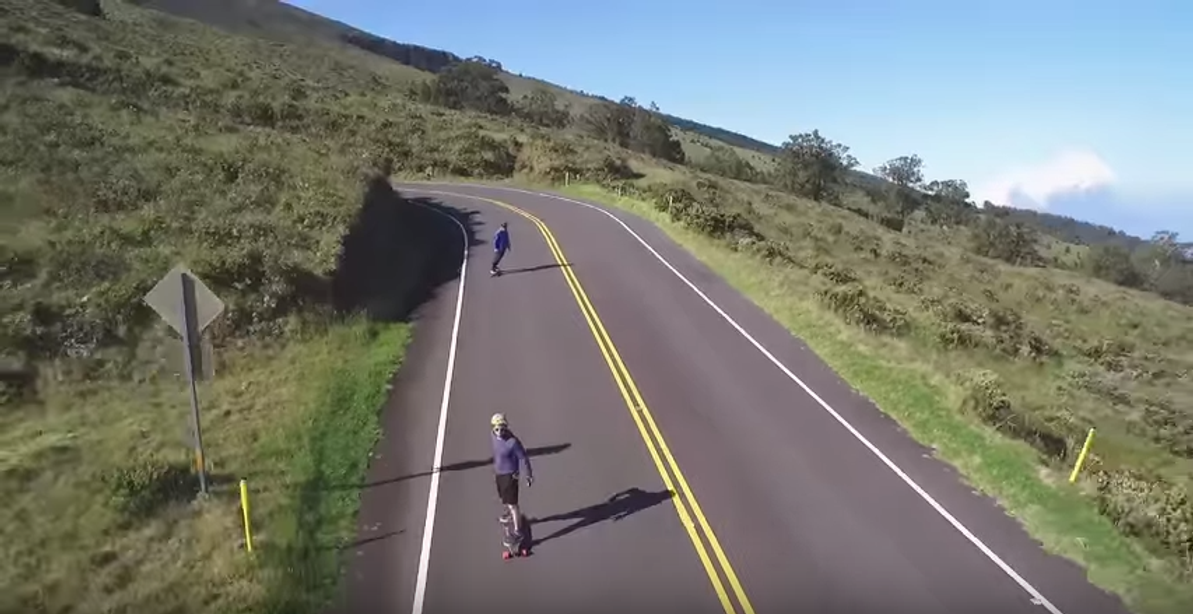Tech Talk: Boosted Boards vs. Yuneec's E-Go Cruiser
Skate Electric
With our recent addition to the family, Boosted Boards, and our tried-and-true Yuneec E-GO, we've caught the electric fever (which sounds like we're all decked out in our parachute pants, wishing we were John Travolta from Saturday Night Fever). While we may not be doing the hustle (because it would end very poorly), we're definitely feeling the electricity in our souls. So, what are these products that are making us wish everything was as easy as these skateboards? Good question.
Boosted vs. E-Go Comparison Chart
|
Boosted Boards |
E-Go Cruiser |
|
| Deck Length | 38 in. / 96 cm | 37.5 in. / 95 cm |
| Weight |
Single - 13.5 lbs / 6 kg
Dual - 15 lbs / 6.8 kg Dual(+) - 15 lbs / 6.8 kg |
13.9 lbs / 6.3 kg |
| Power |
Single - 1,000 Watts
Dual -1,500 Watts Dual(+) -2,000 Watts |
400 Watts |
| Speed |
Single - 18 mph / 28.9 kmh
Dual - 20 mph / 32.2 kmh Dual(+) - 22 mph / 35.4 kmh |
13 mph / 20 kmh |
| Range |
Single - 8 mi / 12.8 km
Dual - 7 mi / 11.2 km Dual(+) - 7 mi / 11.2 km |
18.6 mi / 30km |
| Charging Time | Battery: 60 minutes for all boards |
Battery: 3 - 5 hours Controller: 50 minutes |
| Price |
Single - $999
Dual - $1,299 Dual(+) - $1,499 |
$699 |
Deck Length
While the shape and width may vary between the Boosted Boards and the E-Go Cruiser, the deck length is pretty comparable. They’re both long enough for a variety of riders to enjoy.
Shape
The Boosted Boards feature a narrow mid-section while the Yuneec E-Go Boards are pretty straight throughout. The E-Go Cruiser tapers off towards the motor, and the Boosted Boards feature a gradual hourglass shape.
Weight
The Boosted Boards vary in weight, with the Dual and Dual(+) are definitely the heaviest while the Single is comparable with the E-Go. You can notice the weight with all of the boards, but it isn’t a feat of strength to hang on to them when walking into your house or a restaurant.
Power
The Boosted Boards definitely have more power, with the Dual(+) maxing out at 2,000 Watts. This definitely plays into the speed.
Speed
The E-Go definitely doesn’t have the speed in comparison to the Boosted Boards. But, Yuneec also claims that their design is made for “90% of the riders, 90% of the time”. The Boosted Boards have a little more “oomph” to them, making them perfect for more advanced riders looking for an adrenaline rush. The E-Go is made for those who like to cruise rather than shred, but still want to get to point A to point B relatively quickly.
Range
The E-Go takes the cake with range. Obviously, if you’re going to be running the Cruiser at the maximum speed the range will be depleted. The Boosted Boards are great for short, quick trips.
Charging Time
Boosted Boards have a 60-minute Fast Charge, with 85% of its charge being within the first 30 minutes. The E-Go Battery can charge fully in 3 to 5 hours, and the controller can be plugged in and charged in as little as 50 minutes. If you’re looking for a quick charge, the Boosted Boards are definitely the way to go.
Price
The Boosted Boards can be considered the upgrade from the E-Go. The E-Go has a modest price point, perfect for families and students. The Boosted Boards are slightly more expensive, but the quality is also higher as well.
Our favorite?
Well, we’re pretty divided. Some of the adrenaline-junkies love the Boosted Boards for their speed and carving ability. The Boosted Board feels more responsive than the E-Go, making it great for bumps in the road. But, for some, the deck is too flexible, making it a shaky ride. The E-Go seems to be more stable for some riders, but makes it a little difficult on bumps and cracks in the road. With either choice, it might be a good idea to determine your budget, use, and skating preference. Either way, you won’t be disappointed.



Recent Posts
-
Will YOU ride for peace?
As everyone well knows at this point, Ukraine is struggling with a huge humanitarian and refugee …Apr 14th 2022 -
Why We're Excited About The Serial 1 (Powered by Harley Davidson) E-Bikes
We're excited to announce that we are now a Serial 1 electric bike dealer! Serial 1 (Powered …Oct 1st 2021 -
Why Magnum's New Nomad E-Bike Is Great For Any Outdoor Lover
The Nomad is one of the newest e-bikes to grace Magnum's 2021 product line. The model is …Aug 24th 2021




